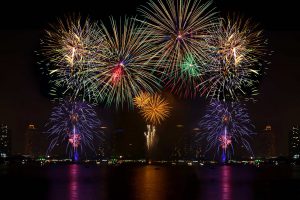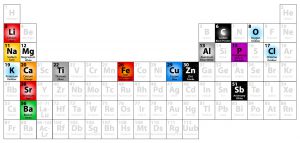 Another Independence Day is in the books, and for many of us in the U.S. it included spending time with friends, family, food and the traditional holiday fireworks. Around the world, fireworks add to the enjoyment of many annual celebrations and events. Their colorful visual and audio display has the ability to thrill us, no matter what age we are. Despite growing older I never seem to tire of fireworks; I’ve also noticed that with each passing year the show seems to get more sophisticated. Whether it be a new color or shape or design of firework, pyrotechnic technology seems to improve at an impressive rate.
Another Independence Day is in the books, and for many of us in the U.S. it included spending time with friends, family, food and the traditional holiday fireworks. Around the world, fireworks add to the enjoyment of many annual celebrations and events. Their colorful visual and audio display has the ability to thrill us, no matter what age we are. Despite growing older I never seem to tire of fireworks; I’ve also noticed that with each passing year the show seems to get more sophisticated. Whether it be a new color or shape or design of firework, pyrotechnic technology seems to improve at an impressive rate.
That got me thinking… how do fireworks actually “work”? Basic chemistry and physics are clearly at play, so in the spirit of a science-related blog I decided to look into this and share what I’ve learned.
A number of engaging websites geared toward all ages do a fine job of breaking down the science of fireworks. And then there are highly detailed and entertaining YouTube videos featuring PhD scientists and fireworks experts who demonstrate the chemistry of fireworks in the lab. As they all point out, “fireworks are just chemical reactions.” The three key components of the reaction include 1) an oxidizer, 2) fuel, and 3) a chemical—in the form of metal salts—to produce color. Basically, the oxidizer breaks the chemical bonds in the metal salts to release the energy stored in their bonds. A bit of fuel in the form of a fuse or direct flame ignites the reaction.
The different metal salts or compounds used in fireworks, the “color concoctions,” are what create the rainbow of colors ignited in the sky. When a particular chemical element burns, its electrons become excited and release energy in the form of light. The amount of energy released, which varies from element to element, is characterized by a particular wavelength of light. Higher energies correspond to shorter wavelength light, whose characteristic colors are located in the violet/blue region of the visible spectrum. Lower energies correspond to longer wavelength light, at the orange/red end of the spectrum.

Deep reds are created by strontium and lithium, orange is from calcium, yellows and golds are produced by sodium, silver or bright white is caused by the burning of magnesium, green comes from the burning of barium, and blues are created by copper. For turquoise or neon green colors, chlorine is combined with barium or copper. Vivid violet-blues are still considered to be the most difficult and dangerous to produce—they release the highest amount of energy corresponding to shorter wavelength light and are the most unstable.
That may explain how different colors of fireworks are created, but what about the actual structure of the firework that propels them so high into the sky? Fireworks are designed as aerial shells made of cardboard or heavy stock paper and resemble ice cream cones. The fuel sits in the cone portion, and the scoop that sits on top contains an outer layer of pyrotechnic “stars”—sparkler-like substances lumped into small spheres, 3-4 cm in diameter, that contain the chemicals needed to produce the desired color. Stars also include a blend of oxidizing and reducing agents and binders which hold everything together. Inside the scoop of stars is the charge that creates the burst.
Interestingly, stars are made by hand and carefully packed into cardboard compartments within the aerial shell. Pyrotechnicians in Italy are credited with inventing these shells in the 1830s; they’re also the ones we can thank for discovering that different metallic powders create specific colors.
As for those cool effects of fireworks such as glittering stars, deepening colors, glow-in-the-dark, and sparkler effects, they too are created by the use of certain chemical elements. Aluminum, antimony, titanium, zinc and phosphorous can do wonders to produce mesmerizing and interesting pyrotechnics.
The more recent phenomenon of creating whimsical shapes such as hearts, smiley faces, geometric designs and the planet Saturn are all about the inner anatomy of the stars packed into an aerial shell. By assembling the explosive stars into the desired shape or pattern within the shell before firing them they reproduce that same shape once ignited. Sounds easy!
Like any good scientific challenge, there is room for improvement and more answers to be found within the field of pyrotechnics. For example, forest green-colored fireworks continue to elude scientists, and fireworks packed to create letters of the alphabet—allowing for fireworks to spell out whole words—are still under investigation. It’s exciting to imagine the direction in which the field could evolve and the displays we may eventually be treated to once solutions are found.
Fun Facts about Fireworks (with an international flair):
- The earliest documentation of fireworks dates back to 7th century China. According to historical accounts, Chinese alchemists accidentally mixed saltpeter (potassium nitrate) with sulfur and charcoal, stumbling upon the crude chemical recipe for gunpowder.
- Today, China is the largest manufacturer and exporter of fireworks in the world – 90% of all fireworks originate from that country.
- The first recorded fireworks in England were at the wedding of King Henry VII in 1486.
- The largest chocolate firework was released in Zurich on New Year’s Eve 2002. It measured 3 m high and 1.5 m in diameter and contained 60 kg of Swiss Cailler chocolates.
- The biggest occasion for fireworks in the U.K. is Guy Fawkes Night (November 5th), a celebration of the failing of the Gunpowder Plot on Nov. 5, 1605, an attempt to kill King James I at the Houses of Parliament.
- The largest firework rocket ever launched was 13 kg and produced in Portugal in 2010.
- The word for firework in Japanese, ‘hanabi’, which actually means “fire-flower.”
- France uses fireworks to celebrate Bastille Day and the storming of the prison of Bastille.
- A string of firecrackers lasting 22 hours straight marked the New Year’s Day celebrations in Hong Kong in 1996.
- The record for the largest firework display consisted of 66,326 fireworks and was achieved in Portugal in 2006.
- Also in 2006, 56,405 fireworks were launched in 30 seconds, the record for time, and set in the U.K.
- In Japan, fireworks occur somewhere almost every day for the entire summer.
- The largest annual pyrotechnic display in North America occurs in Louisville, KY as a prelude to the Kentucky Derby, although the Macy’s Independence Day fireworks are credited as the biggest display in the U.S.
Nicole Sandler
Latest posts by Nicole Sandler (see all)
- Writing Scientific Papers: Is There More To This Story? - February 3, 2017
- Top Science Books of 2016 - January 4, 2017
- The Role of the NanoLuc® Reporter in Investigating Ligand-Receptor Interactions - December 5, 2016
